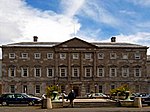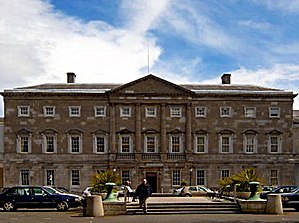Dáil Éireann
| logo | Leinster House, seat of the Dáil Éireann |
|---|---|

|

|
| Basic data | |
| Seat: |
Leinster House , Dublin |
| Legislative period : | 5 years |
| MPs: | 160 |
| Current legislative period | |
| Last choice: | February 8, 2020 |
| Chair: |
Ceann Comhairle Seán Ó Fearghaíl ( FF ) |

|
|
| Distribution of seats: |
Government (84)
|
| Website | |
| Dáil Éireann | |
Dáil Éireann ( Irish pronunciation : [ ˈd̪ɑːlʲ ˈeːɾʲǝn̪ ]; translation: "Assembly of Ireland", also called Dáil for short , "Assembly"; because of the Irish gender actually "the Dáil", but in German usually referred to as the Dáil or the Dáil ) the Lower House of Parliament ( Oireachtas ) of the Republic of Ireland .
The Dáil is elected directly at least every five years; A single transferable vote procedure is used. The last election took place on February 8, 2020 (see also Elections in Ireland ). The powers of the Dáil, the more powerful chamber of parliament, are similar to those of other lower houses in other parliamentary systems . The meetings of the Dáil have been held at Leinster House in Dublin since 1922 .
composition
The (as of 2016) 158 members of the Dáil (called Teachta Dála (TD) or Deputy ) are directly elected by the citizens of the Republic of Ireland at least every five years. You must be at least 21 years old.
choice
You are entitled to vote at the age of 18. The Taoiseach can dissolve the House of Commons at any time by requesting the Irish President , which leads to new elections within 30 days.
Through the system of the single transferable vote (STV), the seats in the Dáil are proportionally distributed. The relatively small constituencies bring advantages to the larger parties and slightly disadvantage the smaller parties. The government has consisted entirely of coalitions since the 1990s. Before 1989, however, one-party governments, mostly through the Fianna Fáil party , were the rule. Because the constituencies always correspond to several seats in the lower house due to the STV, candidates often have to run against members of the same party. This gives the voter more leverage than a list vote . Two attempts to move to the British system of majority voting (1959 and 1968) were rejected by referendums . By-elections take place in the instant runoff voting system.
In 2007, each constituency voted for three to five (average is 3.9) members of the lower house. The Irish Constitution only provides that no constituency can have fewer than three House Members; no upper limit is set (Article 16 (2)). The constituency boundaries must be checked at least every twelve years (Article 16 (2)). Constituency boundaries are currently being worked out by an independent commission whose proposals are normally adopted.
Number of members
There must be at least one member of the lower house for every 30,000 inhabitants and a maximum of one member of the lower house for every 20,000 inhabitants (Article 16 (2)). The Taoiseach and the Tanaiste and the member of the government in charge of the Treasury must be members of the Dáil Éireann (Article 28 (7)). In the 30th Dáil there was one member of the lower house for every 25,500 inhabitants - one of the highest rates in the world. With the adoption of the (current) constitution in 1937, this regulation reduced the number from 153 to 138. Since this led to problems in the 1960s for the Taoiseach Seán Lemass in setting up suitable ministers, the number was then increased. In 1981 there was another increase to the number of 166 members that is still valid today.
Current composition
In the parliament, elected in 2020 and working until 2025, there are nine parties, nineteen independents and the Ceann Comhairle:
| logo | Surname | Alignment | Party chairman / party leader |
Seats | |||
|---|---|---|---|---|---|---|---|
| after the election |
current | +/- | |||||
| Parties | |||||||
|
|
Fianna Fáil (FF) | Irish Republicanism , Conservatism | Micheál Martin | 37 | 37 | ||
|
|
Sinn Féin (SF) | Irish Republicanism , Democratic Socialism | Mary Lou McDonald | 37 | 37 | ||
|
|
Fine Gael (FG) | Christian democracy , liberalism | Leo Varadkar | 35 | 35 | ||
|
|
Green Party (GP) | Green politics | Eamon Ryan | 12 | 12 | ||
| The Labor Party (Lab) | Social democracy | Alan Kelly | 6th | 6th | |||

|
Social Democrats (SD) | Social democracy |
Catherine Murphy , Róisín Shortall |
6th | 6th | ||
|
Solidarity - People Before Profit (SOL-PBP) • People Before Profit (PBP) • Solidarity (Sol) • RISE |
Democratic socialism | collective leadership |
5 3 1 1 |
5 3 1 1 |
|||
| Independents 4 Change (I4C) | Democratic socialism | - | 1 | 0 | 1 | ||
| Aontú (Aon) | Irish Republicanism , Sociopolitical Conservatism | Peadar Tóibín | 1 | 1 | |||
| The Right To Change Party (RTOC or Right To Change) | Democratic socialism | - | - | 1 | 1 | ||
| Independent and Ceann Comhairle | |||||||
| Independent | 19th | 19th | |||||
| Ceann Comhairle | 1 | 1 | |||||
| total | 160 | 160 | |||||
Ceann Comhairle
- Main article: Ceann Comhairle
The speaker, or chairman, of the Dáil Éireann ( Ceann Comhairle ) is elected from among the members of the House of Commons; strict impartiality is required of him. Regardless of this, the government tries to get a chairman from its own ranks.
Powers
Although Dáil Éireann is only one of three pillars of Parliament, along with the President and the Seanad Éireann , the Dáil has arguably the most powerful powers. He can pass virtually any law he wants, as the President is usually obliged to sign any law passed by both Houses of the Oireachtas and the Seanad can usually only delay a law but not prevent it. The Dáil also determines the Irish Prime Minister ( Taoiseach ). Dáil Éireann can ask a vote of confidence; in this case the Taoiseach must either dissolve parliament or resign 1 . The Dáil also has sole power
- propose the budget (as long as it does not concern the Senate)
- Ratify State Treaties
- to declare war or participation in a war.
The Dáil independently determines its own rules of procedure and its members are protected by various laws ( political immunity ). As in other parliamentary systems, the members of the lower house are in principle bound by the specifications of the party and do not vote according to their own discretion. Meetings of the Dáil are public, unless exceptional circumstances arise.
history
Irish House of Commons (13th century – 1800)
- Main article: Parliament of Ireland
The first legislative power in Ireland was the Parliament of Ireland ( Parliament of Ireland ) from the 13th century and whose lower house was the Irish House of Commons ( Irish lower house ). Parliament was abolished in 1800 with the Act of Union .
House of Commons of Southern Ireland (1921-1922)
- Main article: Parliament of Southern Ireland
Only in 1921 the British government abolished the Parliament of Southern Ireland ( Parliament of Southern Ireland ) a new official legislative power in Ireland. This was an attempt to appease nationalists with some sort of limited home rule . However, this institution was rejected and boycotted by the nationalists, whose allegiance remained with the Dáil. However, since the First Dáil was illegal according to British law, the lower house of the Southern Irish Parliament, the House of Commons of Southern Ireland , is still the predecessor of the Dáil there.
Dáil Éireann (House of Assembly) (1919-1922)
- Main article: Dáil Éireann (House of Assembly)
Even before 1921, namely in 1919, Irish nationalists met again under a kind of "revolutionary parliament" based on the unilaterally proclaimed independence. This Parliament is also known as the First Dáil. The name Dáil Éireann comes from this period and although it had successfully performed many government functions, it was never recognized by British law, as was the Second Dáil. Only the Third Dáil, which was elected under the Anglo-Irish Treaty , was considered a kind of transitional lower house.
Dáil Éireann (Chamber of Deputies) (1923-1937)
- Main article: Dáil Éireann (Free State)
In 1921 the Anglo-Irish Treaty created the Irish Free State , which consisted of 26 (of 32) counties on the island. By the election in 1923, the previous transitional lower house ( Third Dáil ) was dissolved and reassembled. The newly elected House of Commons of the Irish Free State (now also referred to as Chamber of Deputies ) was now part of the legislature that was first called Oireachtas ( Irish Parliament ). Both Dáil Éireann and the House of Lords gathered at Leinster House in Dublin . Although the first three Dálaí were never officially recognized, the first House of Commons under the Free State is referred to as the 4th Dáil.
Dáil Éireann (House of Representatives) (1937 – present)
The 1937 Constitution of the Republic of Ireland established the modern Irish state that still exists today. Under this constitution, both the legislature ( Oireachtas ) and the lower house ( Dáil Éireann ) kept the previous name. The lower house was immediately referred to as the "House of Representatives". The first House of Commons to meet under the new constitution is also known as the 9th Dáil ( Ninth Dáil ).
Distribution of seats for the 33rd Dáil Éireann
- Main article: Elections for the Dáil Éireann 2020
Web links
- Website Dáil Éireann (English)
Footnotes
- So far it has only happened once that the resignation did not end in a new election: In 1994 John Bruton ( Fine Gael ) became the new Taoiseach when the Labor Party left the coalition with Fianna Fáil under Albert Reynolds and so changed the government.
- Coalition partners are marked with a circle ( • )
- On November 8, 2008, the progressive Democrats decided to dissolve themselves.
- ↑ Dolf Sternberger and Bernhard Vogel (eds.): The election of parliaments and other state organs (Volume I, first half volume), 1969, p. 657 ff. ( Online )
- ↑ Article 16 (1) of the Constitution of July 1, 1937.
- ↑ Fourth Act to Amend the Constitution (1973); Before that, according to Art. 16 (2), one was entitled to vote from 21.


